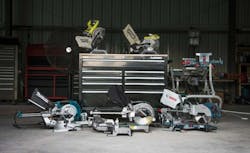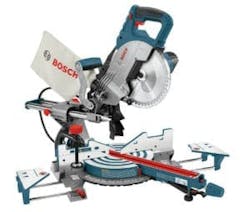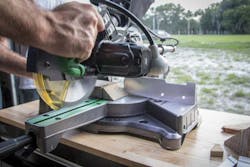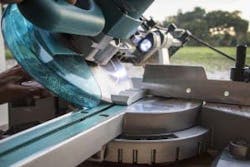Head2Head Tool Test: Compact Miter Saw Shootout
Most of the time you don't need a 10 inch blade, so one of these little buggers will do just fine
Ed's Note: This comprehensive tool review is reprinted with permission from ProToolReviews.com, a comprehensive tool review website, as the name infers. If you are a tool junkie, you should go there and dig through their ditches. There's a lot.
A compact miter saw is one that falls under a 10 inch blade diameter. They’re fantastic tools for jobs that require smaller work pieces and the sliding models can still get you 12 inches of cross cut on 2x material.
You can forget 4x material here, though—at least on a single cut. The 7-1/4 to 8-1/2 inch blades won’t make that without rotating the work piece.
What you lose in cutting capacity, however, you gain in portability and electrical efficiency.
The heaviest of the 5 compact miter saws that we tested was still easily manageable one-handed. A couple were downright lightweights.
What you don't give up are the features that you love.
The Professional level saws here still carry much of the miter and bevel capacity that their larger counterparts do. In fact, they’re basically just smaller models—which is exactly what Pro users want them to be.
So where do compact miter saws really shine? In the hands of finish carpenter, flooring installers, cabinet and furniture makers, as well as cutting case, base, and crown molding.
Plus, you can get a full cross cut on up to 2x12 material or a 45 degree miter on 2x8.
What We Look for in a Compact Miter Saw
In order to put these compact miter saws through their paces, we needed to test them on a variety of materials. We used foam crown molding, untreated 2x2, untreated pine 2x4, and pressure treated 2x8. This gave us an idea of how each saw would cut in common materials where they would have to make cross cuts, mitered cuts, and beveled cuts.
Cutting Performance
More than anything else, if the saw doesn’t cut well, it’s not going to make it to our jobsite.
There’s some room for interpretation here though. After much discussion, we decided to test each saw with the stock blade. We came to this conclusion based on the idea that most users are going to make use of that blade and get the first impressions based on it.
That being said, the performance that we found in each saw could change for the better (or worse!) when you change out that blade.
The Blades
- Bosch CM8S: 8-1/2″ 48T
- Hitachi C8FSHE: 8-1/2″ 24T
- Makita LS0815F: 8-1/2″ 48T
The significance of the blade is not only in its quality, but also its style. With the majority of the applications for a compact miter saw being geared toward finish work, we expected to find finish blades on each saw.
Not so with Hitachi. For what most would consider a framing blade, it did leave us with a surprisingly good cut. However, we’d like to see it paired with a true finish blade.
The Bosch CMS8 miter saw and Makita LS0815F miter saw both included finish blades in their saws, and Bosch’s did very well.
Makita on the other hand, seems to be on a different planet when it comes to stock blades on any of their saws. They seem to package a stock blade that can compete with, and even outperform, some of the best aftermarket blades out there.
Best Stock Blade: Makita LS0815F
The Motors
- Bosch CM8S: 12 amps, 5600 RPM
- Hitachi C8FSHE: 9.21 amps, 5500 RPM
- Makita LS0815F: 10.5 amps, 5000 RPM
There are two basic components when it comes to the cut: the blade and the motor that turns it. There’s room to play with speed and torque in any motor, so we can’t just give away an award for the biggest motor or fastest no load speed. Once you put that motor under load, a completely different ending can be written than the story on paper.
In this case, though, Bosch's bigger numbers translated to better performance, allowing us to power through stressful cuts easier than the others. Make no mistake though, it’s no 15 amp motor.
Most Powerful Cut: Bosch CM8S
Cutting Feel
The part of the cutting performance equation that isn’t as easily quantifiable is the feel of the cut. A lot of times this boils down to preference and ergonomics.
Sometimes, a tool can set itself apart in the ergonomics field by reducing the amount of vibration that the user feels. That’s part of what we noticed.
For these compact miter saws, it’s also about that stock blade. Makita’s 8-1/2″ blade transferred a smooth, stable cutting experience that was noticeably ahead of the others. Another big reason is Makita’s direct drive motor. It provides much great energy transfer over belt driven models.
Combined with solid ergonomics and a near perfect soft start, it was the unanimous favorite in this category.
Best Cutting Feel: Makita LS0815F
Cutting Capacity
- Bosch CM8S: 12-1/4″ @ 90 degrees, 8-5/8″ @ 45 degrees
- Hitachi C8FSHE: 12″ @ 90 degrees, 8-1/2″ @ 45 degrees
- Makita LS0815F: 12″ @ 90 degrees, 8-1/2″ @ 45 degrees
There aren’t really any surprises when it comes to cutting capacity.
Bosch offers an extra 1/4 inch on the cross cut than Hitachi and Makita, which also leads to a slightly longer 45 degree mitered cut.
One area that we were able to set the saws apart was on dado cuts. These are common cuts for carpenters that result in perfectly cut trench in the work piece, usually used for joinery.
They may be common, but most miter saws struggle with them because the curvature of the blade leaves a raised back end. The fix is to either flip the piece and go back over your cut or (more commonly) use a small piece of 2x material to push the piece away from the fence to give the blade more runout.
None of the saws were able to complete a perfect dado cut on one pass. The Bosch CMS8 did leave less additional work to go back and complete. By less, we mean that you could use a piece of 1x instead of 2x to push away from the fence.
Best Cutting Capacity: Bosch CM8S
Favorite Compact Miter Saw Features
The right feature set can push a saw to the forefront of your shopping list if it’s done right and without adding a ton to the price.
Common features on miter saws in general include the mitering and beveling capabilities, lasers for cut lineup, LED lights for dark situations, and dust collection. In the case of compact miter saws, weight and portability also enter into the equation.
Mitering and Beveling
All of the saws have the traditional miter capacity and single bevel capability that you expect from a Pro saw. The positive stops that each saw offered were also solid and easy to find.
That again, leaves just one small feature to separate the three.
In this case it’s Bosch’s miter detent override. This thumb actuated feature allowed us to smoothly pass by the miter stops when we were looking to cut a nonstandard angle … and we loved it!
Best Mitering and Beveling Features: Bosch CM8S
Laser Cut Lineup
Lasers have been touted as no more than “a feature to raise the price of miter saws” according to some users. We say that it’s all about the laser placement.
Lasers mounted above or to the side of the blade can really lead to some accuracy issues. That is, unless you’re cutting in the dark—which is not recommended. Ever.
However, some manufacturers are realizing the benefit of a laser mounted underneath the blade and that has made a world of difference.
Combined with the ability to adjust it for left side, right side, or center blade cuts, these lasers make a difference.
The Bosch CM8S doesn’t include a laser nor does the Makita LS0815F miter saw, so the Hitachi C8FSHE miter saw wins this one by default.
We were able to adjust the lasers to make perfect cuts. Even compared to the lasers on full size miter saws, we loved Hitachi’s design thanks to the tool free adjustment. Simply turning the adjustment wheel with your fingers is all you need to move the laser left or right.
Best Laser: Hitachi C8FSHE
LED Light
Some people will always question the need for an LED light on a power tool. After all, not many people are going to work in the dark.
Sure, there’s limited light in some confined spaces, but not where you’re using a miter saw … right? True, but while the LED light can offer additional illumination in low light situations, that’s not really where it, er, shines.
Where our five Pros found they want light the most is in the shop. Why? Because, unless you’ve got perfect lighting from all directions, you get shadows.
The Bosch CM8S doesn’t offer this feature.
Makita offers an LED behind the blade that shines blue and is pretty easy on the eyes.
Hitachi takes the lead in this category, however. The articulating LED above the blade is attached to a gooseneck that offers very easy movement from side to side so that you can eliminate the shadows exactly where they fall. They’ve even made the neck short enough to ensure you won’t accidentally cut it off.
Best LED Light: Hitachi C8FSHE
Dust CollectionDust collection is a challenge for miter saws. We’ve all used models that make us wonder why they even bother. However, improvements in shroud design have helped to direct more sawdust into the bag than we saw just a few years ago.
While each of these saws can be attached to a dust extractor for maximum containment, we also looked at how they performed with only their respective collection bags.
Makita and Hitachi both caught a reasonable percentage of the dust they created.
Bosch on the other hand, picked up a noticeable amount more of its waste and presented itself as the clear winner.
Best Dust Collection: Bosch CM8S
Weight
- Bosch CM8S: 37 pounds
- Hitachi C8FSHE: 32 pounds
- Makita LS0815F: 31.1 pounds
Hey, this one’s about as clear cut as it gets. Makita is the lightest saw of the bunch!
Lightest Weight: Makita LS0815F
PortabilityPortability is a function of the weight of the saw and the ergonomics of carrying it. Obviously, Makita has the edge in weight with Hitachi just behind.
All three saws can also be locked into a middle slide position to balance the weight.
Makita has an advantage here as well with a rubber overmold on the handle that makes for a slightly more comfortable grip.
Although it’s close, Bosch actually has the best design here. The pivoting handle ensures that the saw will still carry well even if the weight isn’t distributed perfectly in the center. Despite being the heaviest of the group, that handle design made it the easiest to carry.
Best Portability: Bosch CM8S
Durability
When it comes to durability, all three of these saws were clearly built to withstand jobsite conditions.
Bosch sets itself apart with a robust design that includes cast metal where the others had opted for plastic. This was included on knobs, levers, and handles among other points of potential wear. This undoubtedly leads to its higher weight.
Best Build Quality: Bosch CM8S
Value
- Bosch CM8S: $449.00
- Hitachi C8FSHE: $349.00
- Makita LS0815F: $349.99
All of us want the most bang for our buck, and there’s little doubt left here.
Makita’s impressive performance, light weight, solid feature set, and excellent price point win the day in the value category.
Best Value: Makita LS0815F
Tool by Tool: 8-1/2″ Sliding Compact Miter Saws
Bosch CM8S 8-1/2″ Single Bevel Compound Miter Saw
- Motor: 12 amps
- No Load Speed: 5600 RPM
- Miter Capacity: 52 degrees left, 60 degrees right
- Positive Stops: 0, 15, 22.5, 31.6, 45 degrees left and right plus 60 degrees right
- Bevel Capacity: 47 degree left, 2 degrees right
- Bevel Stops: 0, 22.5, 33.9, 45 degrees
- Cutting Capacity: 12-1/4″ @ 90 degrees, 8-5/8″ @ 45 degrees
- Weight: 37 pounds
- Price: $449
- Warranty; 1 year
Pros: In addition to the accolades we’ve already given it, there are a few more big wins for the Bosch CM8S design team.
Bevel adjustment lever is not on the rear where we have to reach all the way around to get to it.As Pro reviewer Matt Kent put it, “The Bosch CM8S has the most booty of all the saws we tested.” We’re pretty sure he’s talking about the cutting power.
Cons: You won’t find a light or laser here even though we’ve seen designs that make both very effective. It’s also the heaviest of the group and the most expensive.
Conclusions: The Bosch CM8S Miter Saw is a Pro tool, hands down. With the best build quality of the group, excellent performance, and outstanding feature set, this one is hard to pass up. Paired with the Bosch T4B Gravity Rise Miter Saw Stand, you’ll love having this miter saw around the shop.
- Motor: 9.2 amps
- No Load Speed: 5500 RPM
- Miter Capacity: 45 degrees left, 57 degrees right
- Positive Stops: 0, 15, 22.5, 31.6, 45 degrees left and right
- Bevel Capacity: 48 degree left, 5 degrees right
- Cutting Capacity: 12″ @ 90 degrees, 8-1/2″ @ 45 degrees
- Weight: 32 pounds
- Price: $349 (also available for $299 without laser and light)
- Warranty: 5 years
Pros: In addition to its outstanding light and laser design, Hitachi has some other solid design features.
- Along with the laser placement, the dust shroud protects the laser from excess debris by covering it as the blade lowers.
- Despite being the smallest motor in the group at 9.2 amps, it really had a confident cutting feel. With a premium blade, that feel can only improve.
- The left backstop pivots to get out of the way for bevel cuts. Many miter saws’ backstops slide, but the tracks often get clogged with sawdust, making them tough to use. The pivoting action avoids this pitfall.
- We were also very happy see that Hitachi included a blade brake on this model.
Cons: There are only two mounting holes on Hitachi’s base, which is shorter than others. You’ll want to attach it to your work surface or stand to avoid it dancing back and forth since there are no forward or rear additional supports.
You’ll also want to upgrade the blade immediately if you’re doing finish work.
Conclusions: The Hitachi C8FSHE 8-1/2″ Miter Saw may not have come out on top in many of our testing categories, but it certainly belongs in this group. Where most people will be turned off is the price point that is equal to Makita’s, but without as high a cutting performance. For those willing to leave the laser and LED light behind, you can save $50 and go with Hitachi’s C8FSE model.
- Motor: 10.5 amps
- No Load Speed: 5000 RPM
- Miter Capacity: 50 degrees left, 60 degrees right
- Positive Stops: 0, 15, 22.5, 31.6, 45, and 50 degrees left and right
- Bevel Capacity: 48 degree left, 5 degrees right
- Bevel Stops: 0, 45 degrees
- Cutting Capacity: 12″ @ 90 degrees, 8-1/2″ @ 45 degrees
- Weight: 31.1 pounds
- Price: $349.99
- Warranty: 1 year
Pros: Despite having the lowest no load speed of the group, Pro reviewer Richard Kent pointed out that he would use this saw over all the others. Why?
- The lower speed kept the temperature lower for cutting plastic and foam molding that higher speeds can melt.
- This is the only compact miter saw we tested that included a cord wrap.
- The defeatable depth stop is also a nice innovation that our pro carpenters pointed out as a feature they really love.
Cons: There isn’t a whole lot to complain about on this model. However, I’d trade a little extra weight in the base to be able to slide the extension wings all the way instead of having to remove them when they’re not needed.
While it’s only a small percentage, some people will prefer to have a laser for cut line up.
Conclusions: The Makita LS0815F 8-1/2″ Miter Saw is a great design that a lot of people are going to love. The combination of features, light weight, outstanding cutting performance, and a fantastic stock blade put this at the top of several of our reviewer’s lists.
A note about Makita’s direct drive motor: it’s a big deal over belt driven systems. Thanks to the design, the motor is able to transfer all of the power from its gearing into the blade. Makita notes that belt driven systems will begin to lose performance through slippage (and RPM’s) as the belt wears out.
The direct drive system will characteristically maintain its performance over time.
—This article is reprinted with permission from ProToolReviews.com, an excellent source of tool reviews (as the name implies). Kenny Koehler, a contributor to ProToolReviews wrote this piece.





















